The structure and dynamics of the Universe are eminently complex phenomena to reproduce, so much so that the most powerful current simulations require several minutes to compute a rendering that sacrifices a great deal of precision. But recently, thanks to artificial intelligence, American astrophysicists have developed a new model capable of simulating the Universe and its evolution in a few milliseconds, while maintaining a spectacular accuracy.
For the first time, US researchers have used artificial intelligence to create a complex three-dimensional simulation of the Universe. Called Deep Density Displacement Model, or D3M, it is so fast and precise that the astrophysicists who conceived it do not understand precisely the totality of the mechanism that underlies it. The study was published in the journal PNAS.
The model accurately simulates how gravity shapes the universe over billions of years. Each simulation takes only 30 milliseconds – compared to the minutes that are usually required for other simulations. In addition, D3M learned from the 8000 training simulations the team provided – extrapolating and surpassing them, able to adjust parameters on which she had not even been trained.
“It’s like driving image recognition software with lots of pictures of cats and dogs, and then it becomes able to recognize elephants,” says astrophysicist Shirley Ho from Flatiron Institute and Carnegie Mellon University. “Nobody knows what’s going on, and it’s a mystery we’ll have to solve.”
Simulating the Universe: a compromise between speed and precision
Simulations are crucial to complement the observations we make of the Universe. By performing simulations that produce results that fit our observations, as well as simulations that do not, cosmologists can determine the scenarios most likely to have produced the Universe in which we live.
But the complexity of the history of our Universe makes such simulations rather tedious, which means that they take time. A single study may require thousands of simulations to obtain useful statistical data. This is where D comes in3M, developed by an international team of astrophysicists. It calculates how, over 13.8 billion years (the age of the Universe), gravity moves billions of particles into space.
With software not supported by the AI, it could take up to 300 hours of computation for a single, highly accurate simulation; this is also possible in just a few minutes, but the precision would suffer greatly. To solve this problem, the research team decided to develop a neural network to run the simulations and trained D3M by providing 8000 different simulations, from an extremely accurate model.
D3M: a fast, accurate and adaptable simulation
Once the training of D3M was finished and the AI was working properly, the model was ready for testing. The researchers asked him to simulate a Universe Cube of about 600 million light-years apart.
To evaluate its results, the team also performed the same simulation with an extremely slow method of several hundred hours and a method taking only a few minutes. As expected, the slow method produced the most accurate result, while the fast method generated a relative error of 9.3%.

A comparison of the accuracy of two models of the Universe. The new model (left), called D3M is both faster and more accurate than an existing method (right) called second-order perturbation theory, or 2LPT. The colors represent the average displacement error in millions of light-years for each grid point, compared to a high precision model (although much slower). Credits: S. He et al. 2019
D3M has surpassed all previous fast methods. Its simulation was carried out in just 30 milliseconds and, compared to the slow but super accurate model, it only had a relative error of 2.8%. Even more impressive, even if it had been formed only one set of parameters, the neural network could predict the formation of the structure of the simulated universe on the basis of other parameters for which it does not exist. had not even been trained – for example, if the amount of dark matter was variable.
This means that the AI can have flexibility to adapt to a range of simulation tasks – although before that, the team hopes to understand how they managed to do exactly what they do.



